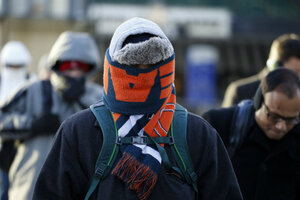Chicago deep freeze: cold, colder, coldest
Chicago just iced it: 26 days of frigid, below-zero temperatures – and counting. With another snowstorm due to hit late Tuesday, Chicago is chasing the record for heaviest snowfall, too.

Commuters brave frigid weather while walking the streets of Chicago earlier this year. The windy city hit its first subzero temperatures in November and, this week, Chicago broke its record for the most subzero days ever reported here: 26.
Jeff Haynes/Reuters/File
CHICAGO
Chicago broke a history record, although people there aren’t rounding a victory lap.
Winter temperatures in the city reached zero degrees F. or below the most number of days since recordkeeping began.
“It’s not just perception that it’s felt particularly brutal this year. The numbers say it,” National Weather Service meteorologist Richard Castro told the Chicago Tribune Tuesday.
The unusually brittle winter brought subzero temperatures to Chicago early, starting in November, where they continued periodically through this week, when temperatures fell to minus-3 degrees at O’Hare International Airport, totaling 26 days when temperatures hit zero or lower. To find a winter as cold, weather trackers had to go back to 1884-85, just a decade after the Great Chicago Fire. That winter had 25 days below zero and not right at zero.
In fact, only six recorded Chicago winters have had temperatures fall below zero: 1884-85, 1935-36, 1962-63, 1981-82, 1874-75, and 1978-79.
Overall, this is the third-coldest winter on record in Chicago, with an average temperature of 18.8 degrees.
Are warming up, at least? Not yet.
Mr. Castro told the Tribune that temperatures will remain cold, with snow continuing to fall at least through mid-March, according to the National Weather Service. With another snowstorm aiming to hit Chicago late Tuesday, the city will likely have its second-snowiest winter since 1884. To date, the city has endured 73.4 inches of the white stuff, which is more than 43 inches above normal.
The deep freeze is also setting records on the Great Lakes. Ice coverage on the Great Lakes reached 90.5 percent, just shy of the 1979 record when ice covered 94.7 percent of the lakes, according to the Great Lakes Environmental Research Laboratory in Ann Arbor, Mich. Last month, when ice covered 88 percent of the surface, it was the greatest ice coverage the lakes had experienced in 20 years.

